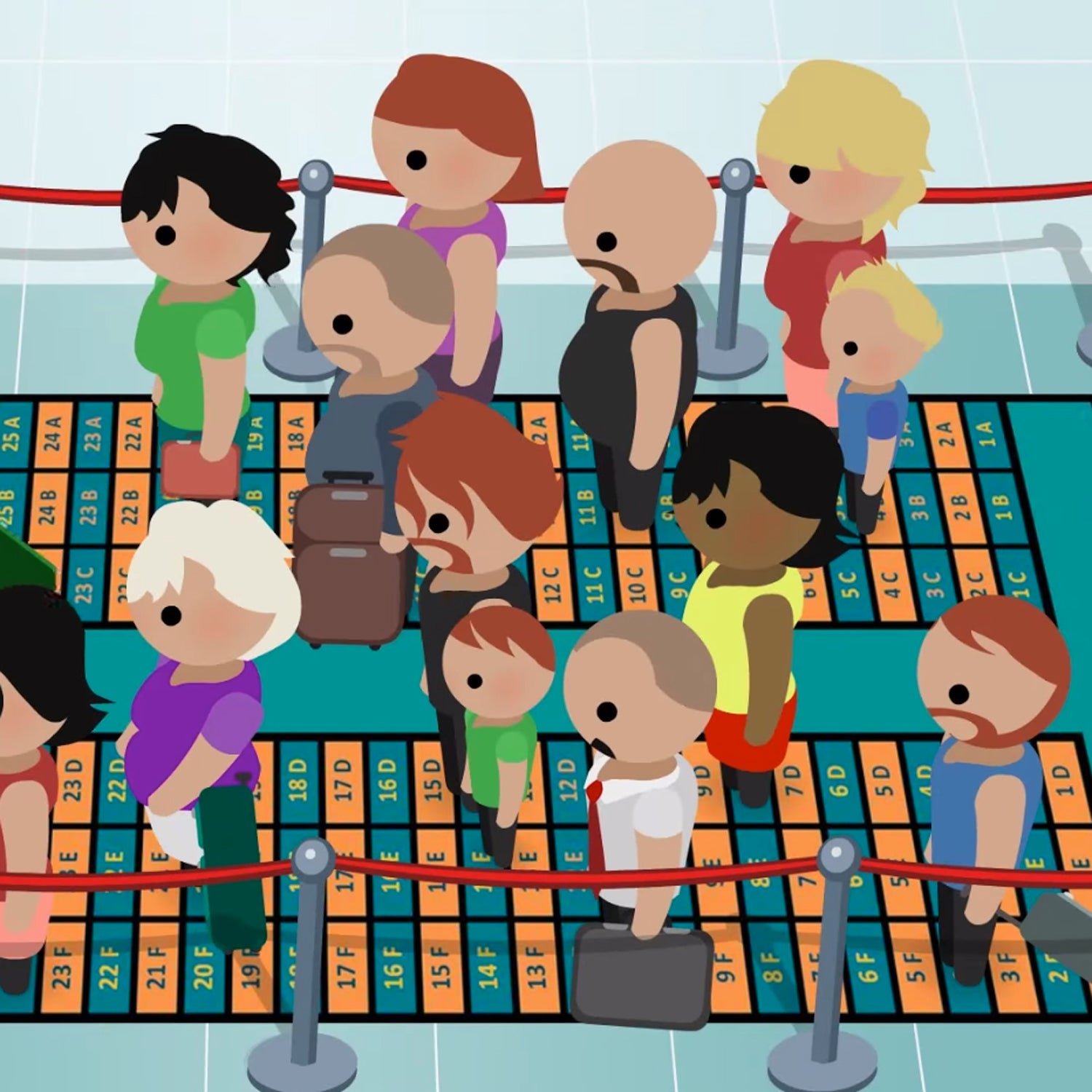Have you ever felt that boarding an airplane was a simple experience? Probably not—the current process of getting to your seat is a tedious, clumsy circus that resembles a game of Tetris left unattended.
But there may be a new solution. t is a patented system by Australian inventor that promises to simplify boarding forever.
Here’s how it works: Picture a rectangular rug printed with an aircraft seating plan in reduced scale, a little larger than a parking spot, placed at the departure lounge gate. At boarding time, 25 to 30 passengers at a time would step onto the carpet and stand on their seat number (on the boarding pass) and color code.
The magic of the carpet is that the passengers are all spaced “logically” along the length of the cabin, so they can easily fill in the rows without bottlenecking. Within a minute, the carpet fills, and those passengers proceed to board while another group takes their place on the carpet. Five or six such groups will fill the typical plane. Individuals, couples, and families can choose to board together.
It’s the most promising solution to boarding backlog since 2008 when Jason Steffen, an astrophysicist at the Center for Interdisciplinary Exploration and Research in Astrophysics at Northwestern University, famously used an algorithm to figure out how to speed the process up. His conclusion: creating buffers between passengers—giving them time to load gear without slowing down the entire line—makes boarding faster.
After running a computer simulation, Steffen found that airlines should begin by boarding passengers in the back row, window seat on one side of the plane. The next person should also be in a window seat but two rows up until the front of the plane is reached. Next, people should fill in the window seats between each row. The process would repeat on the other side of the plane before moving to middle seats and then aisles.
But in the seven years since Steffen published his theory, airlines have not adopted his plan. They’ve stuck with a variety of models that are proven to be and . According to , boarding time took 15 minutes in the 1970s. Today? Thirty to 40 minutes.
Considering that planes sitting idle can cost $400 to $1,000 a minute and , why would companies ignore Steffen’s boarding system? Well, for one, airlines have failed to adopt effective innovations because some customer groups expect to board early, United Airlines spokesperson Rahsaan Johnson says.
Fair enough, but once those “Ruby-Gold-Invincibility-Star” elite customers have been dealt with as well as passengers with special needs, wouldn’t it make sense for an airline then to kick into the Steffen plan? We asked representatives from the major U.S. carriers, who declined to answer directly.
Considering that planes sitting idle can, by various U.S. and European estimates, cost $400 to $1,000 a minute and up to $100 million a year, it seems ludicrous to ignore Steffen’s boarding plan. But airlines have stuck with the old methods.
To be fair, United has adopted a Steffen alternative called the (window seats first, then middle, followed by aisle) which have shown is quicker than other options, but some . According to United’s own internal research, boarding procedures set the tone for the rest of the flight. Without mentioning the Steffen plan, United concluded that “other approaches” brought a feeling of chaos.
In other words: no airline has been able to translate Steffen’s algorithm into a boarding process that passengers can easily understand. But there’s evidence that The Flying Carpet could clear that up. And it’s shown to be faster than current practices. While no airlines have adopted The Flying Carpet, simulations, including ones done by Corporation, have shown that compared to filling a plane back-to-front, the spacing between passengers afforded by Wallace’s carpet cuts time by nearly half, or ten minutes per domestic flight of 180 passengers.
In their simulation, they used the carpet to board five groups of 25 passengers at a time, distributed throughout the cabin, and ran the test 100 times, all the while comparing it to back-to-front, outside-in, and random boarding orders. The carpet bested them all—though, it should be noted that it only came in two minutes faster than the outside-in method. However, the carpet produced more consistent times.
Granted, there are realities that these simulations can’t address. Not all planes come with the same seating charts, which could lead to confusion (though that would only occur on less frequent, two aisle, long-haul flights using the standard single aisle carpet). And you can bet there will be passengers who miss their turn on the carpet. There are other variables such as how quickly a group can assemble on the carpet, walking times, and ability to smoothly place carry-ons in the bulkhead.
Could the Flying Carpet be a solution to the annoying conga line that is airplane boarding? It’s still a tough call. There’s always going to be an unpredictable element individuals bring to the process and to date no carpet—or mathematical formula for that matter—can fix human error.


